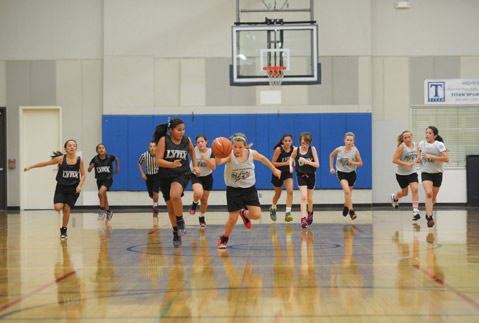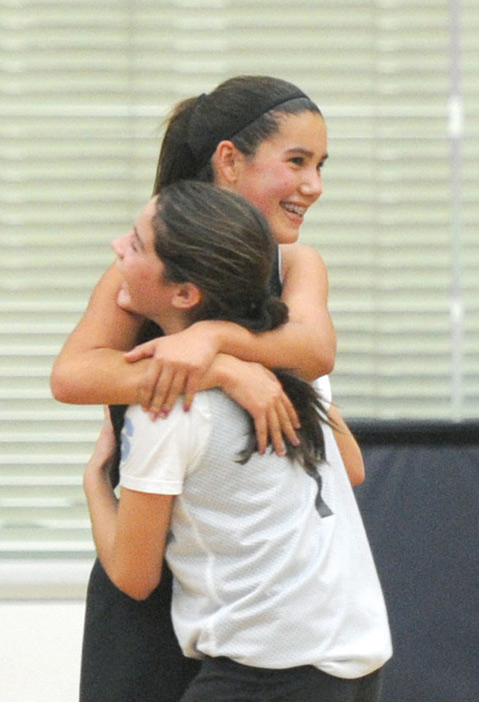Sports: The Page Youth Center
The Page Youth Center Offers Team Sports Galore

in 1984, the Page Youth Center offers basketball leagues in the winter, volleyball in the spring, camps in
the summer, and clinics in the fall. Of the facility, PYC Executive Director Bob Yost said, “[It’s] an island of
sanity and love.”
It was late in a hotly contested basketball game between 5th-6th grade girls. Morgan Jensen-Magne of the Stars collided with Claire Early of the Lynx. Though inadvertent, it was the sort of foul that might result in players glowering at each other. But these two girls hugged. “We’ve known each other since we were a year old,” Morgan explained later.
Spend a few hours in the Page Youth Center (PYC) gymnasium, and you’ll see many such scenes. Good sportsmanship is both preached and practiced during the basketball season that involves 600 children in 1st-8th grades. Executive director Bob Yost calls the PYC’s grounds on Hollister Avenue “an island of sanity and love.” A tryout-and-draft system keeps the teams reasonably well balanced and promotes friendships — your teammate one year may be on the other side the next.

“This is good family time,” said Guy Cekada, whose 9-year-old twins, Brendan and Bradley, were on the same boys’ team. Their grandfather, John Cekada, watched them play with a big smile on his face. Guy tries to downplay the winning and losing part, “but they’re driven,” he said of his sons. “The team’s record is on the Internet. They showed me on a tablet.”
Members of the oldest generation might wax nostalgic about their early sports experiences, remembering how they chose up sides and played for hours in a neighbor’s yard or a park. Just about every school had sports programs run by PE teachers. The only other organized youth sport was Little League baseball.
Those days are long past. There are after-school youth leagues and clubs in a multitude of sports from baseball and softball to soccer, lacrosse, and rugby. The Page Youth Center was founded in 1984. Its gymnasium, which has two full-size basketball courts, was completed in 1991. The PYC offers basketball leagues in the winter, volleyball in the spring, camps in the summer, and clinics in the fall. It also sponsors all-star basketball clubs, the Vipers (boys) and Rebels (girls). Many high school athletes developed their skills in such programs.
“The local community really built this place,” said John Cekada, pointing out the banners that decorate the walls of the gym. There are 60 of them, representing the businesses and institutions that support the center. It is able to provide scholarships for children whose families cannot afford the participation fee ($210 for a basketball season).
Mike and Linda Meyer have watched their daughters, Hannah, 11, and Kate, 9, learn the fundamentals of basketball and make a lot of friends in the gymnasium. Mike is the volunteer coach of Hannah’s team in the 5th-6th grade league and a PYC boardmember. He was a four-year basketball letterman at UCSB in the early ’90s. Linda was a Gaucho soccer player.
It is well documented that there is a dark side to youth sports if they are not put in the proper perspective. The Meyers gave their takes on some major issues.
PERILS OF SPECIALIZATION: In addition to basketball, both Meyer girls have played AYSO and club soccer, and Hannah recently joined a water polo club. It’s unhealthy on many levels for young athletes to play a single sport, according to Santa Barbara clinical psychologist Steven Smith. “Research shows it increases the likelihood of injury and leads to burnout,” Smith said, “and in the long run you don’t become a better athlete. I have data on Division 1 baseball athletes at UCSB that shows they reached an average age of 16 before they specialized.”
The Meyers wholeheartedly agree. “There’s more wear and tear on your body if all you do is play one sport, like hammering your knees and ankles in soccer,” Linda said. “It balances your body out to use different muscle groups. If you play just one sport and quit, you’ll have missed the opportunity to learn another sport. Also, you meet new people in different sports. Our girls can play as many sports as they want as long as they can.” Mike observed, “Ever since Hannah started playing water polo, her soccer and basketball have become exponentially better.” Mike played baseball as well as basketball in high school until his senior year. Linda was a year-round soccer player but also tried volleyball, basketball, gymnastics, and softball. Both parents model a healthy lifestyle. “We’ve done triathlons together, we go on bike rides together, and we try to eat right,” Mike said.
EXPECTATIONS: “We’re trying to raise good, responsible girls, but we want to make sure our kids are still being kids,” Mike said. “It can get serious really fast. We always make sure they’re having fun and want to play.” Linda said, “Sports are important to us because you learn so much about teamwork, camaraderie, how to deal with winning and losing. A bad game doesn’t change who they are or how I treat them and take care of them.” Mike and Linda both were fortunate to receive athletic scholarships at UCSB, but that possibility is not the reason they want their daughters to play sports. Linda said, “It’s something new to me, to hear parents talking so much about college scholarships. Some actually pick a sport for their kid because of that opportunity: ‘You shouldn’t play soccer, because so many people play soccer.’ People’s egos get involved. It saps the fun out of it. Do we ever say [about their daughters], ‘Could they?’ Sure we do. Are we banking on it? No.”
COACHING AND SPECTATING: While their kids are learning to play the game, parents have to learn how to behave. Among the no-nos: coaching your child from the stands. Yelling at the referees. Disagreeing with the coach in front of your child. Unloading a critique on your child after a game. “Those are all things to avoid,” Mike said, “and sometimes it’s easier said than done.” He takes his own coaching very seriously and finds it hard not to say things like, “Move your feet,” and, “Stop the ball,” when he’s a spectator at Kate’s 3rd-4th grade games. He and Linda both go out of their way to applaud good plays by girls who are not on their daughters’ teams.
The Page Youth Center pays its referees, and they appear to be well respected. “I like to see a clean game, not a physical affair with kids all over the floor,” Mike said. Although the referees tend to be forgiving when the younger players carry the ball a few steps, he said, “There’s no way either of my daughters should double-dribble and not be called for it.” As for questioning a coach, Mike said the best approach is to send an email expressing your concerns. If the inquisitor happens to be your wife, it’s another story. After Hannah’s team blew a 10-point lead and lost a game last week, Linda said, “We had a family conversation over dinner. It was about Mike’s coaching strategy.”



